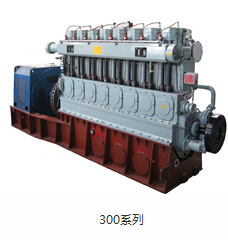1 燃气内燃机燃烧发电
1. Gas internal combustion engine combustion for power generation
燃料和空气以适当的比例在燃气燃气内燃机的气缸内混合、压缩、点火、燃烧,火焰迅速传遍整个燃烧室,同时放出大量热能。燃烧气体急速膨胀,压力和温度都迅速升高,推动活塞往复运动,通过连杆推动曲轴做功,带动发电机发电,动能转换成电能,利用燃气、燃油等一次能源作为燃料用于发电的效率通常在30~40%左右,还有近一半的热量通常直接散失掉,不仅造成能源的大量浪费,而且加重了环境污染。如果回收利用燃气内燃机的高温排烟后将其温度降低至20℃,约可提高40~50%的能源利用效率[3]。
Fuel and air are mixed, compressed, ignited, and burned in an appropriate proportion in the cylinder of a gas internal combustion engine. The flame quickly spreads throughout the entire combustion chamber, while releasing a large amount of heat energy. The combustion gas expands rapidly, the pressure and temperature rise rapidly, pushing the piston to move back and forth, driving the crankshaft to do work through the connecting rod, driving the generator to generate electricity, and the kinetic energy is converted into electric energy. The efficiency of using Primary energy such as gas and fuel oil as fuel for power generation is usually about 30~40%, and nearly half of the heat is usually lost directly, which not only causes a large waste of energy, but also aggravates environmental pollution. If the high-temperature exhaust gas from a gas internal combustion engine is recycled and reduced to 20 ℃, it can increase energy utilization efficiency by approximately 40-50%.
2 高温烟气余热利用
2. High temperature flue gas waste heat utilization
燃气内燃机的排烟温度一般在450~550℃左右,通过烟道将排烟收集起来输送至余热锅炉(额定蒸汽压力2.5MPa),通过余热锅炉回收利用该部分热量,根据用户蒸汽需求量调节烟气三通阀门控制进入余热锅炉的烟气量,生产出可用于充装移动供热车的饱和蒸汽,当余热锅炉不运行时,通过调节烟气三通阀门将烟气由烟囱排出。燃气内燃机与余热锅炉的匹配根据项目的具体情况可以是单台燃气内燃机对应一台余热锅炉(一对一),也可以多台燃气内燃机对应一台余热锅炉(多对一)。上述余热锅炉设备采用双锅筒纵置式,锅炉本体主要由上下汽包、对流管束等受压元件组成,其特点是锅炉本体中的上下汽包长短相同,下汽包与上汽包由对流管束相连,受热面积大,具有一定的超负荷能力,属于全水冷结构,自然循环运行,运行安全平稳。
The exhaust gas temperature of gas internal combustion engines is generally around 450~550 ℃. The exhaust gas is collected through the flue and transported to the waste heat boiler (with a rated steam pressure of 2.5MPa). The heat is recovered and utilized through the waste heat boiler. The three-way valve of the exhaust gas is adjusted according to the user's steam demand to control the amount of exhaust gas entering the waste heat boiler, producing saturated steam that can be used to fill mobile heating vehicles. When the waste heat boiler is not running, By adjusting the flue gas three-way valve, the flue gas is discharged from the chimney. The matching of gas internal combustion engines and waste heat boilers can be based on the specific situation of the project, which can be a single gas internal combustion engine corresponding to one waste heat boiler (one-to-one), or multiple gas internal combustion engines corresponding to one waste heat boiler (many-to-one). The above-mentioned waste heat boiler equipment adopts a double drum vertical arrangement, and the boiler body is mainly composed of pressure components such as upper and lower steam drums, convection tube bundles, etc. Its characteristics are that the upper and lower steam drums in the boiler body are of the same length, and the lower and upper steam drums are connected by convection tube bundles, with a large heating area and a certain overload capacity. It belongs to a fully water-cooled structure, operates naturally, and operates safely and steadily

.
3 低温烟气余热回收
3. Low temperature flue gas waste heat recovery
余热锅炉利用后的低温烟气温度仍然有100~190℃左右,在余热锅炉排烟口安装节能器,把经过处理后的锅炉补水通过管道输送至节能器,利用该部分低温烟气热量加热锅炉补水,进一步回收余热锅炉的排烟热量,降低排烟温度,后由烟囱排出。与常规锅炉相比,回收这部分热量可以提高5%以上的效率[3]。但排烟温度也不宜过低,一方面需要加大换热面积,设备投资增加,另一方面排烟温度过低会生成硫酸,腐蚀节能器中的换热管道,即酸露点腐蚀,影响系统的安全稳定运行,一般设计排烟温度要高于烟气酸露点温度10℃以上[1];如果燃气内燃机燃料中不含硫,以保证节能器受热面不产生凝水为准,即经过节能器回收低温烟气热量后的排烟温度应高于水的露点温度10℃以上[4]。所以,综合考虑烟气余热回收效果以及设备投资,节能器可选择性价比较高的材料,例如ND钢。
After the utilization of the waste heat boiler, the low-temperature flue gas temperature is still around 100-190 ℃. An energy-saving device is installed at the exhaust port of the waste heat boiler, and the treated boiler make-up water is transported through pipelines to the energy-saving device. This part of the low-temperature flue gas heat is used to heat the boiler make-up water, further recovering the exhaust heat of the waste heat boiler, reducing the exhaust temperature, and finally being discharged from the chimney. Compared with conventional boilers, recovering this heat can increase the efficiency by more than 5%. However, the exhaust gas temperature should not be too low. On the one hand, it is necessary to increase the heat exchange area and increase equipment investment. On the other hand, if the exhaust gas temperature is too low, it will generate sulfuric acid, corrode the heat exchange pipeline in the energy-saving device, that is, the acid dew point corrosion, and affect the safe and stable operation of the system. Generally, the designed exhaust gas temperature should be above 10 ℃ above the acid dew point temperature of the exhaust gas [1]; If there is no sulfur in the fuel of the gas internal combustion engine, it is necessary to ensure that the heating surface of the energy-saving device does not produce condensation, that is, the exhaust temperature after the low-temperature flue gas heat is recovered by the energy-saving device should be more than 10 ℃ higher than the dew point temperature of the water [4]. Therefore, considering the effectiveness of flue gas waste heat recovery and equipment investment, energy-saving devices can choose materials with higher cost-effectiveness, such as ND steel.
需要注意,燃气内燃机的排烟依次经过烟气管道、烟气三通阀、余热锅炉、节能器、烟囱,其压力损失需要经过详细核算,使得其终的排气压力必须限制在燃气内燃机大允许排气背压值以内,以保证燃气内燃机的稳定运行。
It should be noted that the exhaust gas of the gas internal combustion engine passes through the flue gas pipeline, flue gas three-way valve, waste heat boiler, energy-saving device, and chimney in sequence. The pressure loss needs to be carefully calculated, so that the final exhaust pressure must be limited to the maximum allowable exhaust back pressure value of the gas internal combustion engine to ensure the stable operation of the gas internal combustion engine.
另外,系统设计时应按照标准选择合适的管道保温材料以及保温厚度,并且尽量缩短燃气内燃机和余热锅炉间的烟气管道长度,不仅能够降低燃气内燃机排烟在传输过程中的热量损失,还可以减小压力损失。
In addition, when designing the system, appropriate pipeline insulation materials and thickness should be selected according to standards, and the length of the flue gas pipeline between the gas internal combustion engine and the waste heat boiler should be minimized as much as possible. This not only reduces the heat loss during the transmission process of the exhaust gas from the gas internal combustion engine, but also reduces the pressure loss.
4 余热锅炉补水
4. Makeup water for waste heat boiler
通过水处理设备处理后的余热锅炉补水,需要经过除氧器热力除氧,然后送至节能器加热,为余热锅炉运行提供不间断的水源。另外,为了防止锅炉补水过程中出现气蚀的现象,在锅炉补水泵组与除氧器之间安装一台加压泵。水处理装置可采用常规的全自动软水器,以制取锅炉软水,或者根据锅炉补水水质采取其他水处理装置,例如反渗透设备、离子交换、EDI电除盐系统装置等。
The make-up water of the waste heat boiler treated by the water treatment equipment needs to be thermally deoxidized by the deaerator, and then sent to the energy-saving device for heating, providing uninterrupted water source for the operation of the waste heat boiler. In addition, to prevent cavitation during the boiler water replenishment process, a pressurized pump is installed between the boiler water replenishment pump group and the deaerator. The water treatment device can use conventional fully automatic water softeners to produce boiler soft water, or other water treatment devices such as reverse osmosis equipment, ion exchange, EDI electric desalination system devices, etc. can be used based on the quality of boiler makeup water.
余热锅炉排污水通入排污膨胀罐进行减压处理,不仅可以提高系统运行的安全性能,而且在排污膨胀罐中可产生二次蒸汽,然后通入补水箱中预热锅炉补水,提高能源的利用效率。
The waste heat boiler sewage is discharged into the sewage expansion tank for pressure reduction treatment, which not only improves the safety performance of system operation, but also generates secondary steam in the sewage expansion tank, which is then preheated into the make-up water tank to improve energy utilization efficiency.
2.5 蒸汽输送过程
2.5 Steam transportation process
余热锅炉生产出的饱和蒸汽通过蒸汽管道送至分气缸,然后从分气缸的出口输送至充装系统的干管,经由充装系统的支管分别对移动供热车进行蒸汽充装,后运输至用户处,释放出用户所需压力的蒸汽。蒸汽充装系统示意图见图2。另外,从分气缸的其他出口引出部分蒸汽用于余热锅炉补水的热力除氧。
The saturated steam produced by the waste heat boiler is sent to the sub cylinder through a steam pipeline, and then from the outlet of the sub cylinder to the main pipe of the filling system. The mobile heating vehicle is filled with steam through the branch pipes of the filling system, and finally transported to the user to release the steam required by the user. The schematic diagram of the steam filling system is shown in Figure 2. In addition, a portion of steam is extracted from other outlets of the sub cylinder for thermal deoxygenation of the waste heat boiler's makeup water.
 全国服务热线:
全国服务热线:
 全国服务热线:
全国服务热线: 济南济柴环能燃气发电设备有限公司
济南济柴环能燃气发电设备有限公司
 .
.

